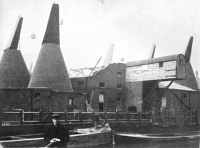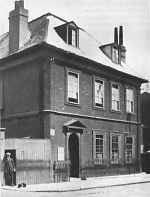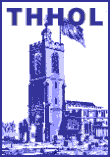The mythical Scotch colony in Bromley in the reign of James I is associated with Tudor House, which was situated in the Lower High Street, otherwise Four Mills Street (St. Leonard's Street). It was an interesting mansion with garden and grounds occupying an area of about one and a half acres, and having a frontage of two hundred feet. When the property was purchased by the London County Council in 1898, the house was in excellent condition, especially the older parts of its interior, and could it have been allowed to remain standing would have been a pleasing relic as one of the residences in the old village that contained picturesque houses with tiled roofs and richly carved cornices and canopies. Built in the late sixteenth century, it underwent some changes a hundred years later, in the time of William III, and again in the first years of the nineteenth century. Who were the earliest occupiers is not known, but there is no evidence of it having had Scottish inhabitants. It was bought in 1737 by Gilbert de Flines, a Dutch merchant, who conducted his business in the parish of St. Bartholomew in the City of London. In the following year, by a codicil to his will made in 1736, he bequeathed the estate to one Mary Williams otherwise Hays, and afterwards to her children (if any), but if she should die childless then to her brother Walter for life only, and at his death to 'the Minister and Churchwardens for the time being, of the Parish of Bromley . . . in Trust for the use and benefit of the Poor of the Parish for ever.'
Mary Williams entered into possession, but subsequently sold her life estate to a Mr. Barton, who also purchased the reversionary interest of Walter Williams, who, surviving his sister, died in 1766: whereupon Messrs. John Lefevre and Joseph Taiwin, the church wardens, made a formal entry 'into and upon the Garden belonging to the said Premises and cut a sod of Earth and a Twig therein.' The demand for possession was met in a charming, prepossessing manner of defiance by the tenant, a Mr. Debonnaire, who, true to his name, was unembarrassed in the situation, and on this and on other occasions later genially remarked 'Do what you can.' At his death his daughter Anne succeeded in possession, and a month after her decease in February 1829 the Public Vestry 'in solemn conclave sate' and decided that the claim, which had been recognised at least on the part of the parish at various times, although not enforced, should be submitted to Counsel's opinion. The reply forthcoming was: 'The Charity can make no effective claim, regard being had to the time which had elapsed.' The parishioners came to the conclusion that it would be a useless expense to proceed further, and mournfully bewailed 'That the poor should have been deprived of what was intended for their benefit' without alluding to their own culpable neglect. The property was subsequently let on a tenancy to a Mr. Tudor, whose name by becoming attached to the house has caused confusion in many minds of a later generation.
The site of the house and gardens is now included in the Recreation Ground, which was opened to the public in 1900. There, at its northern end, can be seen one of the old massive entrance gateways from Northumberland House, Whitehall, which was demolished in 1873 for the making of an approach to the Victoria Embankment. Among the other features are a couple of eighteenth-century wooden ship's figure-heads that, strangely enough, have here found a port.
A little further down the main street the sometime village ended. It was not large, and the oldest maps of the locality now extant show that the inhabited parts of Bromley lay by the river Lee. In 1648 there were in the parish seventy-six houses and tenements said to be worth £664 6s. 3d. per annum; and arable, pasture, and market gardens worth £636 8s. per annum. The street joined the ancient way leading to the site of the 'four mills 'that were in existence seven centuries ago. Formerly there was a triangular plot of ground at this place which was called Coventry Cross, and nearby (the end of Empson Street will serve to identify the spot) a public house with that sign. In the days when there were no other convenient meeting-places for the disposal of business connected with local affairs, these premises served as an occasional parochial rendezvous. By the old inhabitants the name of Coventry Cross is still remembered though few can precisely locate it. Having regard to the persistence in the survival of names, though often in corrupt form, long after the objects to which they referred have vanished, it is feasible that in the pre-Reformation period a cross stood here belonging to either the Convent of St. Leonard or that of Holy Trinity, Aldgate; perhaps raised for the guidance of such wayfarers as traversed the lonely track across open country from the Thames side.
 Through
the parish, dividing it nearly in halves, passes the canal, the Limehouse Cut, which was opened
for traffic in 1770 as a direct communication between the Thames and the Lee, to save the circuitous
navigation round the Isle of Dogs. For many years it did not affect the neighbourhood, but the
time came when factories of all kinds were erected on its banks and brought about a disfiguring
change. This waterway, that appears to-day as an ugly slit, dirty and depressing to view, was
pleasant to behold when it went through land unbuilt upon, and then seemed to other eyes than
ours a silver sash across a waste. Where it reaches the Lee there stood until a few months ago
a familiar landmark, the Bromley Maltings, and the illustration [left] shows the buildings
in the first stage of demolition. A new river wall has been recently made, and owing to the
nature of the subsoil, pile foundations for the blocks of dwellings will be necessary.
Through
the parish, dividing it nearly in halves, passes the canal, the Limehouse Cut, which was opened
for traffic in 1770 as a direct communication between the Thames and the Lee, to save the circuitous
navigation round the Isle of Dogs. For many years it did not affect the neighbourhood, but the
time came when factories of all kinds were erected on its banks and brought about a disfiguring
change. This waterway, that appears to-day as an ugly slit, dirty and depressing to view, was
pleasant to behold when it went through land unbuilt upon, and then seemed to other eyes than
ours a silver sash across a waste. Where it reaches the Lee there stood until a few months ago
a familiar landmark, the Bromley Maltings, and the illustration [left] shows the buildings
in the first stage of demolition. A new river wall has been recently made, and owing to the
nature of the subsoil, pile foundations for the blocks of dwellings will be necessary.
Until the making of Brunswick Road through the lands of the Lower Manor the iron gates of the Bromley Hall estate pre vented the continuance of a direct public way towards Poplar. The then existing public road was by Bow Lane, which went round outside the enclosed manor fields, thus accounting for the semicircular bend in St. Leonard's Road which follows the contour of the old lane. There was a private road from the Hall, which, after leaving the manor fields, crossed the marshland with its ditches and bogs. On account of the mire it went through it was appropriately called Quag Lane.
On the east side of Brunswick Road, opposite the end of Venue Street, stands to-day Bromley Hall, now occupied by the Royal College of St. Katherine, which maintains an Infant Welfare Centre in co-operation with the Poplar Borough Council. The house does not look as old as it really is, as it was entirely remodelled in the latter half of the eighteenth century.
 Bromley
Hall is the Manor House of the Lower Manor, and stands upon the site of the principal mansion
in the original Manor of Brambeley where Lady Ida Triket held her customary Court in the reign
of Richard I, to which reference has already been made.
Bromley
Hall is the Manor House of the Lower Manor, and stands upon the site of the principal mansion
in the original Manor of Brambeley where Lady Ida Triket held her customary Court in the reign
of Richard I, to which reference has already been made.
The manor having passed into the possession of Holy Trinity Priory, Aldgate, the lands comprised therein were afterwards let on lease, the last being granted for the term of thirty years, from Midsummer 1509, to John Blount, esquire, of ''the manor and farm of Bramlegh, with all lands, meadows, &c. (except a tenement with garden and orchard in the tenure of John Chyrchman.)' The profits arising out of the manorial rights were reserved by the lessors. Before the lease ran out, however, the monastic property had beem seized by the Crown; and subsequently the Commissioners, acting on its behalf from time to time, granted fresh leases. On reversion to the Crown in 1606 the manor, then described as the Lower Manor, was sold outright. William Ferrers died in 1625 possessed of it, and in Bromley Church there is an interesting monument of this gentleman, of his wife and infant son. It is composed of alabaster, with panels of black marble. Under arches supported by pillars are the demi-figures, coloured and gilt, of William and Jane Ferrers. In a panel over the effigies there is this motto:-
Liue well, and dye neuer,
Dye well, and live eauer.
Beneath is a niche containing the figure of a sleeping child, who lies with his head on a golden tasselled pillow, and a rose in his hand. On either side on the panels below are these words
As nurses strive
theire Babes in bed to lay
When they too ly-berally
the wantons play.
Soe to prevente
his farther growinge crimes,
Nature his nurse,
gott him to bed betimes.
The inscription beneath is as follows:-
'Here lyes ye body of William Ferrers ye only son and heyre of Will Ferrers Esquire Citizen & Mercer of London, who tooke to wyfe Iane one of ye daught' of Sr. Peter Van-Lore, of London Knight by whom he had one childe, His Wyfe & childe dyed both before him and he departed this lyfe a month before his Father. He was a gentleman of religious sovle towardes God and a sweet behaviour towardes Menn and his death was by his kindred and generally mvch lamented. He dyed the 25th. of August 1625 and left his Vncle Thomas Ferrers his Executor who to the memory of him hath erected this monument.'
In this most pure and blessed shade
(Such by the sacred ashes made,
That here inhabit must) does lye
The man whose virtues cannot dye.
His alms, his prayers, his pyety,
Have sent his sowle abpve the sky.
Nature full well had taught his wyfe,
To sow her powers in pius lyfe
To God, to friend, to poore, to all,
Shee was as good as we dare call
Frail flesh: good passenger give prayse
To them who made such happy dayes.
Some readers may find it necessary to read the inscription more than once. They will be rewarded for their pains.
by Sydney Maddocks
